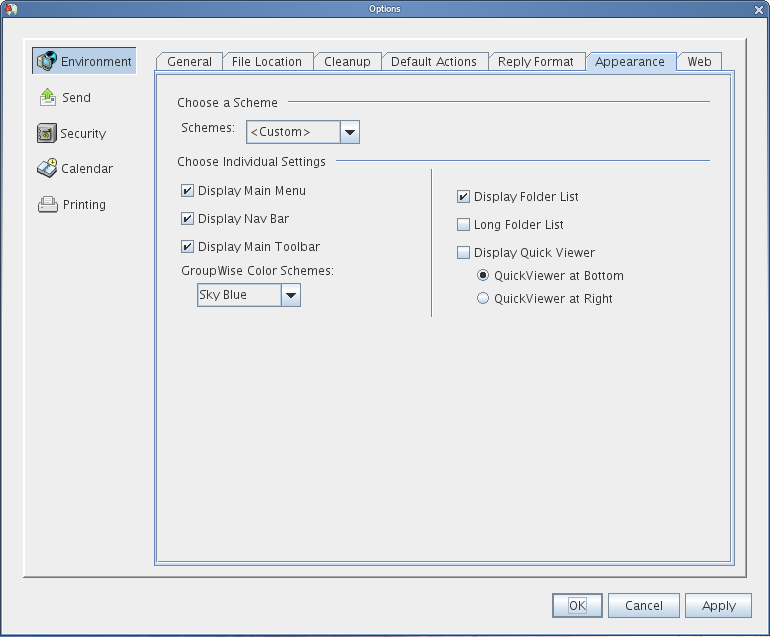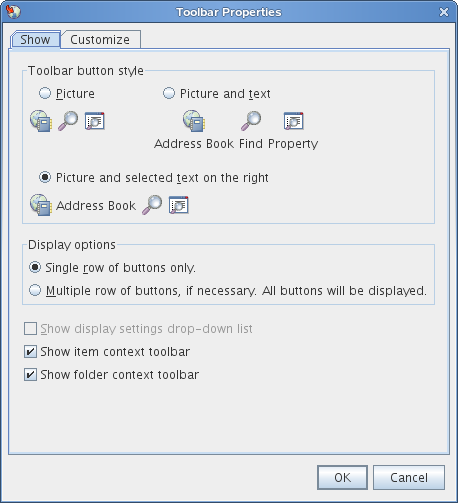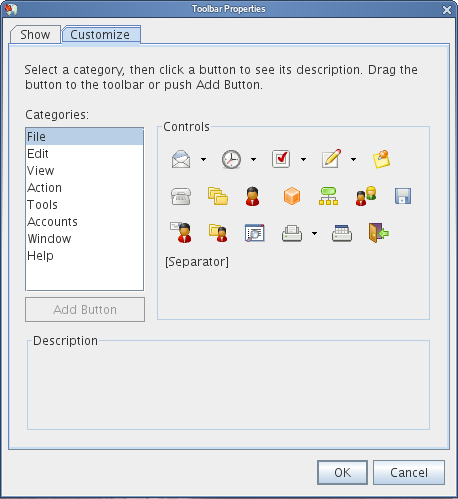2.1 Customizing the GroupWise Interface
You can select to customize the look and feel of GroupWise in many different ways.
2.1.1 Selecting a GroupWise Scheme
You can select from four schemes:
-
Default: The Default scheme has a new color scheme and displays the Nav Bar, Full Folder List, the Main Menu, and two columns with panels.
-
GroupWise 6.5: The GroupWise 6.5 scheme has the Folder List, Main Toolbar, and Item List, displaying in the old colors.
-
Simplified: The Simplified scheme has a new color scheme and has the Nav Bar, Simple Folder List, and two columns with panels.
-
Custom: The Custom scheme allows you to set the appearance settings however you like. If you edit one of the predefined schemes, those settings become your Custom scheme.
To select a scheme:
-
Mac: Click > .
Linux: Click > .
-
Click > .
-
Select a scheme from the drop-down list.
-
Click , then click .
2.1.2 Customizing GroupWise Appearance Settings
-
Mac: Click > .
Linux: Click > .
-
Click > .
-
Select .
-
Select the appearance settings you want for GroupWise.

Schemes: See Section 2.1.1, Selecting a GroupWise Scheme.
Display Main Menu: Displays the Main Menu above the Nav Bar.
Display Nav Bar: Displays the Nav Bar for quick access to your most used folders.
Display Main Toolbar Displays the Main Toolbar for quick access to your most common functions.
GroupWise Color Schemes: Overrides any operating system color schemes for the selected GroupWise color scheme.
Use GTK Look and Feel: Use the look and feel of the Linux desktop.
Display Folder List: Displays the Folder List on the left side of the window.
Long Folder List: If the QuickViewer is displayed, select this option to extend the Folder List to the bottom of the QuickViewer when it is displayed below the Item List rather than to the right.
Display QuickViewer: Select this option to display the QuickViewer, or leave it deselected to prevent the QuickViewer from displaying.
You can also customize individual folders for QuickViewer display. Right-click a folder, then click . Select or deselect and as needed.
QuickViewer at Bottom: If is selected, this option displays the QuickViewer at the bottom of the window.
QuickViewer at Right If is selected, this option displays the QuickViewer at the right of the window.
-
Click .
2.1.3 Customizing the Main Toolbar
You can customize the Main Toolbar by adding and deleting buttons, choosing button order, and placing separators between buttons.
-
Mac: Control+click the Main Toolbar.
Linux: Right-click the Main Toolbar.
-
Click .
-
Click the tab.

-
Select whether you want the toolbar to display text with the button pictures.
-
Select if you want a single row of buttons, or multiple rows of buttons if necessary.
The option is dimmed because it is not currently available in the Mac/Linux client.
In addition to the Main Toolbar, item views also have customizable toolbars.
-
To show the buttons that are most useful for an open item, select .
The Tasklist folder and the Trash folder also have customizable toolbars.
-
To show the buttons that are most useful for the Tasklist or Trash folder, select .
-
Click the tab.

-
To add a button, click a category from the list box, click a button in the box, then click .
The categories correspond to menu titles in the Main Window. The buttons in the box correspond to features found under the menu title. For example, the buttons for the File category are actions under the menu (opening views, printing, saving, and so on).
HINT:You must keep the tab open as you perform the following steps.
-
To remove a button, drag it off the toolbar.
-
To change the order of a button on a toolbar, drag it to where you want it to display.
-
To add or remove space between buttons, drag one button away from or toward the other button.
-
Click .
2.1.4 Setting Your Default Start Folder
By default, GroupWise displays your Mailbox folder. After you set up your Home folder, you might prefer to start in your Home folder instead.
To change the view for all items:
-
Mac: Click > .
Linux: Click > .
-
Click .
-
Select if you want to start GroupWise in the or .
-
Click .
2.1.5 Setting the Default Read/Compose View
Be default, GroupWise uses HTML as the default Read View and Compose View. You might prefer to use the Plain Text view instead.
-
Mac: Click > .
Linux: Click > .
-
Click .
-
Make selections in the and group boxes.
HTML-only messages are displayed in HTML, even though you have selected for the default read view.
-
Select a default font style.
-
Select a default font size.
-
Click .
To change the view in one item:
-
Open an item.
-
Click , then click or .
2.1.6 Automatically Reading the Next Item in Your Mailbox
You can configure GroupWise to automatically open the next item in your mailbox after you accept, decline, or delete the item you are reading. By default, this option is disabled.
-
Mac: Click > .
Linux: Click > .
-
Click > .
-
Select , then click .
2.1.7 Changing the GroupWise Interface Font
You can change the font for the GroupWise interface. This is helpful, for example, if you are visually impaired and need a larger or easier-to-read interface font, or if you just find another font more attractive than the default.
NOTE:You must restart GroupWise after changing the interface font for your changes to take effect.
-
Mac: Click > .
Linux: Click > .
-
Click > .
-
Select a font and font size in the drop-down lists, then click .
-
Restart GroupWise.
To return to the default font, select the blank font and font size at the top of the lists.
2.1.8 Changing the GroupWise Interface Language
If you have the multilanguage version of GroupWise, you can select the interface language.
-
Mac: Click > .
Linux: Click > .
-
Click > .
-
Select a language in the drop-down list, then click .
HINT:To change the Spell Checker language, see Selecting the Spell Checker Language.